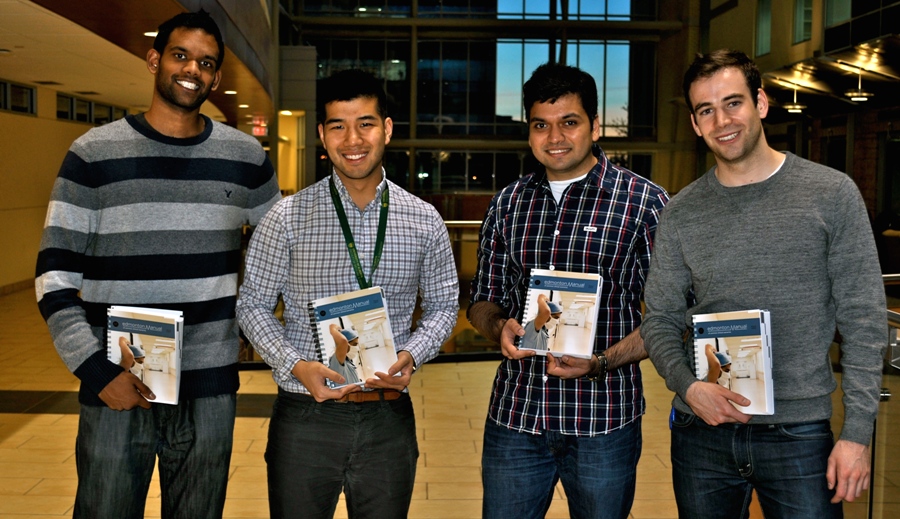
Edmonton Manual editorial team L-R: Haran Yogasundaram, Anthony Lott, Nikhil Raghuram, Brent Turner. Absent: David Lesniak, Lina Wang, Henrique Fernandes, Susie Lindquist
University of Alberta medical students are helping their colleagues across the country prepare for clinical examinations with the Edmonton Manual, a comprehensive guide that outlines more than 140 common clinical encounters. The third edition was released in December 2013.
The Edmonton Manual originated as an informal text compiled by graduating medical students to help third-year medical students prepare for Objective Structured Clinical Examinations (OSCEs), which assess students' clinical history taking and physical examinations skills at the end of a clinical round. In 2009, senior medical students Shaheed Merani (MD '10), Aaron Knox (MD '10), Ryan Gallagher (MD '11) and Jasmine Pawa (MD '12) became inspired to create a formal publication.
Medical students, residents and U of A staff physicians collaborated to develop accurate and complete approaches for common clinical encounters. The first edition of the Edmonton Manual was released in 2010.
"The Edmonton Manual is based on the Licentiate Examine of the Medical Council of Canada Part 2 learning objectives. We've gone through every single objective and tried to develop a station that would approach the topic," said Anthony Lott, fourth-year medical student and the manual's editor-in-chief. "There's everything from physical exam stations-how you do a cardiac or respiratory examination-to patients who come in with what we call undifferentiated problems.
"It's a 'for-students by-students' publication."
The second edition, released in 2011, sold more than 1,700 copies to university book stores, medical societies and individuals. Haran Yogasundaram, second-year medical student and junior director of marketing and sales for the Edmonton Manual, says the Amazon book listing also attracted medical students worldwide, including sales in Hong Kong and the United States. The third edition has sold approximately 350 copies since its release.
As it developed, the Edmonton Manual proved its validity beyond clinical OSCEs. First- and second-year medical students refer to it as they study for their year-end OSCEs, which teach the necessary skill sets to work with patients. Residents often refer to it as they prepare for their final licensing exams.
"A lot of the stuff that we're expected to know for the OSCEs at the end of first year and second year are covered in this manual," Yogasundaram said of his own preparation. "It's definitely a helpful tool."
The editorial board is student-led and self-sustaining. Students are recruited for a three-year term at the end of their first year of medical school and assume a more senior role with each passing year. The third edition's editorial board consists of Lina Wang and Henrique Fernandes, associate editors; Brent Turner, junior editor; Anthony Lott, senior editor and David Lesniak, editor-in-chief.
Preparations have begun for the fourth edition, which is expected to be released in January 2015.
The Edmonton Manual is published by the Medical Students' Association (MSA). Proceeds from the manual's sales are distributed between the MSA for operating costs, the senior class's graduation fund and a charity of choice. This year's charity has not been finalized, though Lott and Yogasundaram hope to continue the tradition of donating to a literacy charity.
The Edmonton Manual is available for purchase on the Edmonton Manual website, on Amazon.ca, in the U of A bookstore and in medical bookstores across Canada.